Analytics, Demography, Education and Science, Latvia, Society
International Internet Magazine. Baltic States news & analytics
Friday, 19.04.2024, 11:05
In January, out of 9 212 couples 60.4% were still married, 32.6% were divorced in Latvia
 Print version
Print version
The results acquired will provide opportunity to estimate number of divorces in upcoming years and to study processes of family migration (internal and international). Base period used for the research is year 2001, as on it the oldest statistics on marriages is available in administrative registers, moreover it is possible to update the information with the latest data.
Till 1991, the number of marriages and divorced in Latvia was rather high. During the period from 1991 to 1996, when Latvia regained its independence, a change in population habits may be observed – number of registered marriages is reducing rapidly, while number of divorces is decreasing comparatively slower (relative indicators are falling as well). Starting from 1996, the number of marriages and divorces registered in Latvia annually is smaller, but stable. Due to the improvement of economic situation in the country, notable rise in the marriage number was recorded in 2007 and 2008. Whereas in 2011, along with the introduction of the legislation easing divorce process and possibility to divorce marriage at notary, the number of divorces increased.
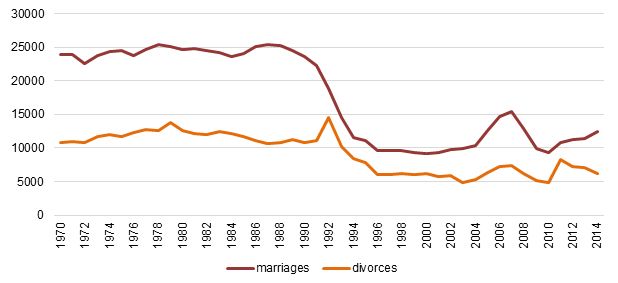 |
| Number of marriages and divorces in 1970 – 2014 |
In 2001, 9 258 marriages were registered in Latvia; for 72% it was first marriage and for 24% – second marriage. The study does not include 46 foreign couples, the information about marital status of which is not available in administrative registers.
On 1 January 2016, out of 9 212 couples 60.4% were still married, 32.6% were divorced, while 7% marriages ended as one of the spouses had passed away.
25.8% of couples married in 2001 currently have no children, 34.6% have one common child, 30.1% – two children, 8.0% – three children, and 1.5% – 4 or more children. The statistics do not include children of one of the spouses.
The main duration of marriage till divorce is 4–7 years (every year 2.7–3.7% of couples divorced). Increase in the number of marriages lasting for 10–11 years meets the time period, when also notaries were allowed to divorce marriage.
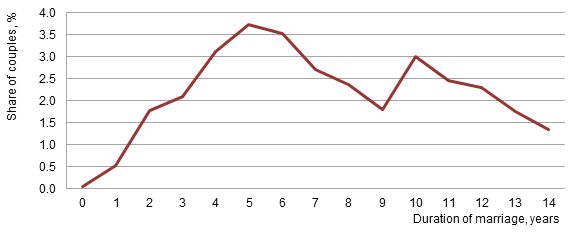 |
| Duration of marriage for couples married in 2001 |
10.2% of all couples, who married in 2001, had common children at the moment, when the marriage was concluded. 23.4% of couples had their first child in the first marriage year (2001), while 21.0% had first child in the second marriage year (2002). Second child in most families was born in 3–7 years after the marriage was concluded, whereas third child most often was born in 8–12 years.
At the beginning of 2016, out of the total number of couples married in 2001 and still living together 93.8% lived in Latvia, 73.5% – still lived in the same region as in 2001, and 63.7% – in the same county or city under state jurisdiction. In line with the international practice, place of residence of a couple, if it is not the same for both spouses, is determined basing on the place of residence of the male. The research shows that couples without children mainly live in Riga or cities under state jurisdiction, whereas couples with two or more children – in small towns or rural municipalities.
Within the framework of the research also influence of the average spouse age, age difference and educational attainment thereof on the possible divorce was studied.
In 2001, the average age of the persons marrying was between 17 and 88 years for males and between 16 and 91 years for females. The average age of male at the moment, when the marriages was registered, was 31 year and age of female – 28.5 years. The research allows concluding that, the higher average age of couple at marriage the lower possibility of divorcing. On average males are 2.5 years older than females. However, research results indicate that age difference does not influence divorce risk.
Analysis of the educational attainment of couples married in 2001 is based on the Population and Housing Census 2011 data (10 years after the marriage registration). In 40.0% of the total number of corresponding couples females have acquired higher level of education than males, in 38.5% both spouses have equal educational attainment, while in 21.4% – education of husband is higher.
The research allows concluding that couples, in which both spouses have equal educational attainment are still married (65% of all couples married in 2001).
To estimate the possibility of
divorcing, the male and female educational attainment difference was
calculated. The results acquired are graphed, showing higher educational
attainment of male on the right and higher educational attainment of female on
the left.
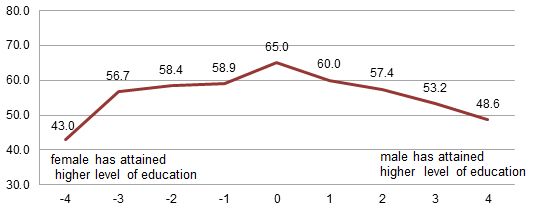 |
| Share of couples still married by difference in educational attainment (%) |
Male with a lower level of education is greater "threat" to marriage (possibility to stay together equals 43%) than female with lower education (possibility to stay together – 48.6%). However, in both cases, as difference in educational attainment increases, the possibility of divorcing rises.
Among couples, which have acquired higher level of education, the possibility to be still married is higher. Persons with basic or lower education are more likely to divorce, regardless the educational attainment of the other spouse.
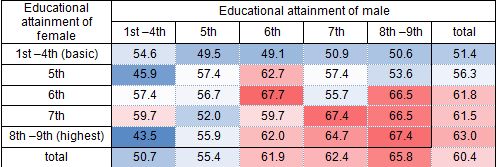 |
| Possibility that couple is still married by level of education acquired by spouses (%) |
Research on persons married in 2001 covers only a period of 15 years. Assessment of future marital status of the married couples is based on the analysis of the share of divorces among the marriages concluded in the corresponding year. For example, if couple married in 1984, but in 2014 it divorced, duration of the marriage thereof is 30 years. As a result estimates are made for the percentage share of couples married in 1984, which divorced in 2014. The curve acquired is compared to the divorce line of couples married in 2001.
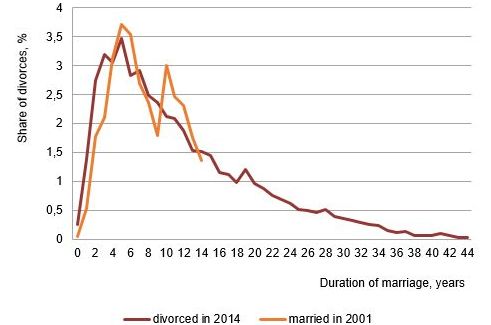 |
| Share of divorces in the marriages concluded in the corresponding year (%) |
Both curves in the common part indicate similar trend, except the break caused by the economic crisis and option to divorce at notary. Experts assume that divorce estimate for the couples married in 2001 will be somewhat similar to the curve depicting divorces registered in 2014, and they forecast that in future 14.4% more of the couples married in 2001 will divorce.
When analysing marriages registered in 2001, CSB experts estimate that, adding 32.6% of couples, who have already divorced till 1 January 2016, 47% out of the total number of couples married in 2001 will divorce during their lifetime. While 53% will stay legally married till the end of their life.








 «The Baltic Course» Is Sold and Stays in Business!
«The Baltic Course» Is Sold and Stays in Business!

